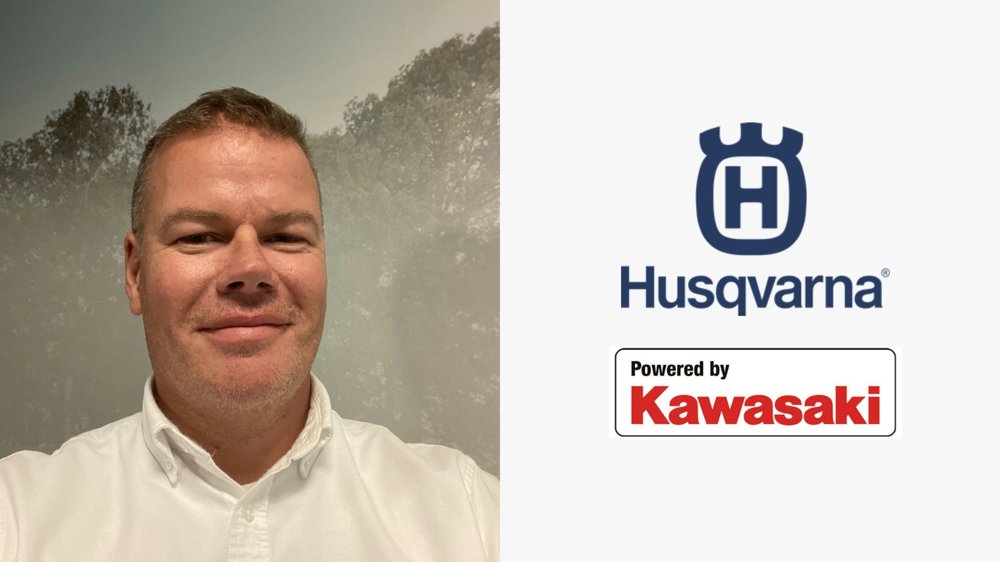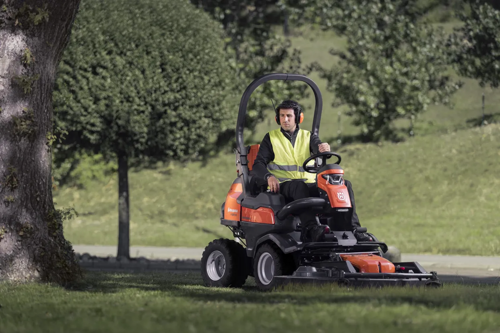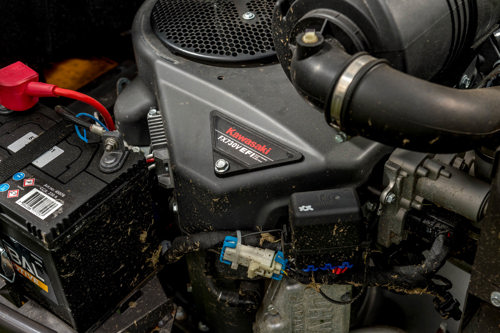Powered by Kawasaki: Introduction to Husqvarna
13 Dec 2023 Kawasaki Community
Husqvarna is one of the most experienced and reputable manufacturers in the world. The Swedish company has built a reputation for breaking new ground with high-quality outdoor equipment, and is pioneering some exciting technology for the landscaping industry.
Husqvarna and Kawasaki Engines have worked as partners for decades; together, we work to provide landscaping professionals with some of the best equipment on the market.
We spoke to Daniel Mannerström, Director of Product Management at Husqvarna, to help our customers learn more about the manufacturer, and gain some valuable industry insights.
What is the core ethos of Husqvarna?
Dare to innovate and believe in new ideas is our core ethos. It's been like that forever; had we deviated from that path, the company would never be able to look back at 330 years as a product manufacturer. You can visit the Husqvarna museum to get some insight into our history – I’m sure you’ll find a few surprises!
I think innovation sits in our DNA. We’re not hesitant to go for it and forge ahead on emerging technologies. We launched our first robotic mower in 1995 and we have been, and continue to be, a world leader in autonomous turf solutions since then. Now we’re working with bigger solutions into even larger applications with more demanding power requirements.
And going hand-in-hand with our drive to innovate are our efforts to lead the industry in the shift to low-carbon, resource-smart solutions; our ambitions include goals to reduce absolute CO₂ emissions by 35% by 2025. You can find out more about Husqvarna’s approach to driving the sustainability transformation on our website.
Husqvarna was founded in 1689. What can you tell us about the company’s long history?
A lot has changed in 300 years! In the very beginning, Husqvarna was a weapons manufacturer, but when demand faded the focus soon turned to other technologies. I think recognising those changes in demand and being quick to adopt and develop new tech is something that has never changed at Husqvarna – and is no small part of our continued longevity. Our engineering precision has crossed many different industries and we’re always looking to the next technology; we were already producing motorcycles in 1903, and our first motorized lawn mower for commercial use was introduced in 1947.
You can see that striving to push boundaries and think outside the box is nothing new to the company. We were early pioneers with microwave ovens, we were the first to introduce the automatic chain-brake in a chainsaw, and of course, the extremely manoeuvrable Rider concept that was prototyped in 1985. There are so many more, I could honestly go on forever!
Are there any particularly notable innovations Husqvarna has made in the landscaping industry?

Husqvarna’s autonomous robotic mowers, which we made available in the 90s, is one I can immediately point to. They’re an immensely popular piece of tech, and with the incorporation of larger and boundary-wire free equipment, are also growing in commercial applications. And we are by far the market leader in robotic mowers.
Another innovation, which will be launched in 2024, is the remote-controlled commercial Front Mower (P524XR EFI), which will be ground-breaking in the commercial sphere for handling steep slopes. On our residential side, we have a unique and extremely efficient collection system in our RC300 series Riders, which vacuum the clippings from the lawn and compact them to take up half the space than in a regular lawn mower. Everything we manufacture, from commercial to residential, has been designed to fit a certain customer need – we’ve produced equipment for decades, and are constantly evolving it to improve the user experience.
Why does Husqvarna choose Kawasaki engines for equipment? How do you select an engine for a machine?

Kawasaki has a reputation, the knowledge that it simply works. If someone asks what engine it is – it’s a Kawasaki? Okay, move on: there's no debating on whether it’s good or bad; everybody knows it's good.
The Kawasaki EFI is an excellent addition. It’s so powerful and responsive; it can maintain RPMs even through tall, thick grass. Using a mower with a Kawasaki EFI engine allows high efficiency and productivity when mowing, and it also has a lower fuel consumption compared to carburetted engines. It’s definitely been a success with our customers.
In terms of selecting an engine for a machine, the first thing we need to consider is obviously if it fits in our products! Then it’s reliability. We need durability and reliability in an engine – it needs to start every time you try to start it, and hold up against the expected hours of use. Reasonable fuel consumption and a match to our service schedule, so you’re not needing irregular services in a year, are also important considerations. Ultimately, the performance has to be there, and the spec has to fit the application. Our products with Kawasaki engines have that engine because it ticks all of those boxes.
How important is the partnership between Husqvarna and Kawasaki Engines?
Long-term relationships are more important than ever in these times; it’s important that we trust in who we’re working with – people that we know are capable of producing great results. We have worked with Kawasaki Engines for a long time, and a healthy working partnership has been key to that.
Even when there were some struggles during the pandemic, we worked through them because the relationships were strong. We have frequent meetings with the team at Kawasaki; they’re communicative, which is so important, and very easy to work with.
How do you guarantee the quality of Husqvarna equipment?
Most importantly – we do a lot of field testing in real-life conditions. Checking the functionality of the equipment, the user experience, the performance. Everything needs to be smooth and responsive, and the mower needs to operate well mowing both very low and very high grass.
We do the endurance testing in-house. We have test rigs to simulate the worst conditions a mower could possibly encounter, and accelerate the hours to test the structural integrity of the machine; it’s a stress test, to guarantee its durability and long service life. The machine is also tested in hot and cold temperatures. There’s a huge testing programme that checks off everything you could possibly think of to guarantee performance and quality.
What do you think have been the biggest changes in the industry in the last 10 years?
Robotics is obviously a huge one, and autonomous machines. They’ve had a huge impact on the industry. Other than that, there’s the rise of electric in landscape machinery. It’s been a big transition, and the technology has come on leaps and bounds in the last decade.
Electric mowers are growing in popularity. What role do you think petrol engines will have going forward?
The power and energy needed for mowing grass with conventional, commercial ride-on mowers is much higher than you might think, because you more or less load the engine fully all the time while mowing. You could compare it to a steep uphill climb with your car the whole time.
A battery stack capable of a full day’s use is huge and, of course, expensive. While petrol does have extra running expenses and a higher CO₂-footprint, it’s certainly important to weigh up the costs. At this stage, the up-front cost of a battery powered ride-on mower capable of keeping up with the power output of a petrol engine is high.
The long-term importance of internally combusted engines will be heavily dependent on the availability of fuels with low CO₂-emissions, be it “biofuels” or “E-fuels”.
What can customers expect to see from Husqvarna in future?
We’ve got plenty of exciting innovations going on – calling back to our ethos of constant innovation, we’re launching a remote-controlled ride-on mower next year. It will allow people to trim certain areas and slopes that would otherwise be challenging and become even more productive, reaching more areas with the same machines, without the need for touch-up trimming. Generally, our customers can expect to see us at the forefront of new technology.
We will continue to look for ways to improve our products and drive technology forward, particularly for our commercial customers. We’re also looking to broaden our product catalogue to meet customer needs; we want our customers to have the ability to choose the majority of their equipment from Husqvarna, knowing the quality will be there. We want that full range, from small trimming equipment all the way up to large ticket machinery.
And finally, our customers can expect to see us become ever more green-conscious. We’re on a journey to become an even more sustainable company, and we are taking notice of the challenges our customers are dealing with in relation to environmental initiatives and regulations – even on a local scale. We have a lot of sustainability targets that we are committed to following. If you’re looking for specific numbers and goals, they can be found in the Husqvarna Group Sustainovate Progress Report 2022.
Husqvarna is a partner that, like Kawasaki Engines, strives to provide the best equipment available for customers. Discover their Powered by Kawasaki range of equipment here, and find the next addition to your kit. For more content like this, subscribe to our newsletter and get access to the latest industry insights.
You may be interested in
-
Congratulations to Richard Willis, our latest brushcutter prize winner!

-
How will environmental legislation like ULEZ affect landscapers?

-
Help us shape our support for professional landscapers – take our survey today!

-
Kawasaki Engines parts and technical manager Jon Couling discusses the support network that keeps landscapers working year-round

-
Kawasaki Engines Christmas Quiz

-
Iwan Jones joins the ranks of Kawasaki prizewinners winning a brand new multi-tool







